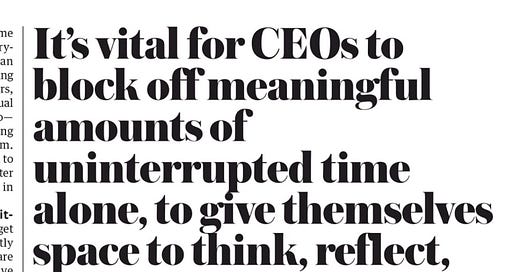Doctors and CEOs Need Time to Think
Published July 4, 2018 and "Time to Think" has Shrunk...
I’ve always likened the job of a primary care physician to that of a Chief Executive Officer of a small business. Family doctors manage the “business” of delivering and coordinating care for more than a thousand patients at an average cost, in the United States, of $8,500 per year – an $8-$12 million business. Because the actions or inactions of the PCP impact the need for, and cost of, specialist and hospital care “downstream” from the primary care office, I think of this as “our” business.
Because of this, I subscribe to the Harvard Business Review. I figure doctors must have some degree of common business sense. And in my medical education, the slant of the business education I got was mostly relevant in the context of Socialized Medicine. I think that is helpful and useful in my practice in a medically underserved area, but there’s more to primary care than serving the underserved on a national level.
Reading the article “How CEOs Manage Time” in the current issue of HBR, I was struck by how light the “grueling” schedule of an American CEO is compared to that of an ordinary family practitioner: 9.7 hours of work each weekday and 3.9 hours on each weekend day.
I was also intrigued by the statistic that 61% of CEOs’ time is spent face to face and 24% on electronic communication. Only an unspecified fraction of 15% is spent on reading written reports.
Undocumented as far as both CEOs and physicians, as far as I know, is how much time we spend researching and thinking. A pullout quote rings true for doctors as well:
I do think it is crucial for primary care doctors to consider the value of their time in a businesslike manner. I know our employers do, but I suspect there is much confusion and disagreement about how to make the best use of our time. In simpler times, doctors just saw patients and brought in professional fees commensurate with their efforts.
But in today’s climate, where outcomes data is starting to determine office revenue and where the health of casual or infrequent visitors to our offices affects our bottom line, we need to claim the value of our time – and I feel strongly that we must leverage our knowledge for the biggest possible impact within our organizations and for our patient populations.
That impact will be less and less determined by line worker type activities such as traditional face to face office visits, and more and more by how we guide and coordinate more and more aspects of our enrolled patients’ health care.
We have added layers of staff to do this coordination work, but in many cases physicians have been peripheral, remaining too heavily involved in the traditional physician activities and not lending their medical common sense and “street smarts” to what could easily become a bloated and disconnected layer of bureaucracy.
Just like a CEO can be the originator and spokesperson for a corporate philosophy while making sure there are middle managers who can reinforce the message on a daily basis, we must be able to shape the overarching medical philosophy and the clinical pathways within our organizations. By doing that, we can more safely delegate tasks while also constantly overseeing and officially promoting and supporting the work that is done by care managers, health educators, nurses and medical assistants.
But just like CEOs, we can’t be spending all our time in meetings, face to face encounters and answering electronic messages. We need some time to research, consider and create. And the more our routine tasks spill over into nights and weekends, the less chance there is that we can think creatively and leapfrog our organizations into the next level of healthcare delivery.





You suggest: "Just like a CEO...we must be able to shape the overarching medical philosophy and the clinical pathways within our organizations." Perhaps I'm too pessimistic, but I find myself wondering if this is ever possible in big business, corporate medicine.